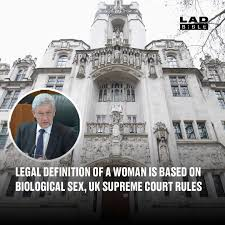UK Supreme Court Ruling on Legal Definition of ‘Woman’ Marks Historic Shift
Definition of woman is based on biological sex: U.K. court
Context: The recent UK Supreme Court’s judgment has redefined the legal interpretation of “woman” under the Equality Act 2010 as biological sex rather than gender identity. This ruling is significant for debates around transgender rights, women’s rights, and the intersection of law, identity, and equality. It offers a critical case study for India in navigating constitutional rights, inclusion, and policy clarity.
Background of the Case
- Originated from a 2018 Scottish Government guidance aimed at improving gender representation on public boards.
- The guidance included trans women with Gender Recognition Certificates (GRCs) within the definition of “woman”.
- For Women Scotland (FWS), a gender-critical advocacy group, challenged this, citing conflict with the Equality Act 2010.
- Lower Scottish courts upheld the government’s view, prompting FWS to escalate the case to the UK Supreme Court.
- The case garnered widespread attention with support from public figures like J.K. Rowling and lesbian rights groups.

Supreme Court Ruling: Key Observations
- The terms “woman” and “sex” in the Equality Act 2010 refer to biological sex, not legal gender identity.
- A GRC does not override sex-based provisions under the Equality Act.
- Dual interpretations of sex (biological and legal) would create confusion in public policy, service delivery, and administration.
- The Court cautioned against interpreting the decision as a victory of one group over another, emphasising judicial neutrality.
Implications of the Ruling
- Legal Clarity and Interpretation
- Provides definitive guidance on the application of the Equality Act 2010.
- Clarifies the legal foundation for single-sex spaces, reducing interpretive ambiguity.
- Helps public and private institutions to structure legally compliant policies.
- Women’s Rights and Sex-Based Protections
- Reinforces biological sex-based rights in domains such as: Hospital wards, Changing rooms, Prisons, Shelters & Sports competitions.
- Ensures legal protections for women-only services and spaces remain intact.
- Impact on Transgender Rights
- Trans women with GRCs may be excluded from single-sex spaces if proportionate and justified.
- Raised concerns over:
- Employment discrimination
- Access to public services
- Social inclusion and mental health
- Public Policy and Administrative Effects
- Necessitates policy revisions across: Healthcare, Education, Charities & Public boards.
- Prompts review of the Gender Recognition Act 2004 to align with this legal interpretation.
- Encourages creation of sex-based provisions in workplaces and public institutions.
- Human Rights and Constitutional Balance
- The Court reaffirmed that trans individuals remain protected under the ‘gender reassignment’ category of the Equality Act.
- Calls for coexistence of rights, ensuring dignity, equality, and social justice.
Broader Legal and Ethical Dimensions
- Gender Identity vs. Biological Sex
- The ruling reignites the debate on whether identity-based self-determination should override biological classifications.
- Raises fundamental questions on how law defines identity.
- Judicial Neutrality and Role of Courts
- Reaffirms the functional role of courts in balancing competing rights.
- Avoids taking a partisan stance amid culture wars.
- International Relevance
- Similar debates are unfolding in:
- United States: Trump-era policies emphasised biological definitions.
- Other common law jurisdictions: May take cues from the UK precedent.
- Similar debates are unfolding in:
Way Forward
- Legislative Review
- Review and harmonisation of the Gender Recognition Act 2004 and Equality Act 2010.
- Introduce precise statutory language to reduce interpretive conflicts.
- Inclusive Policymaking
- Design policies that acknowledge biological sex without disenfranchising trans individuals.
- Develop dual-track protections under separate legal categories.
- Dialogue and Public Awareness
- Promote informed public discourse to reduce polarisation.
- Engage civil society in law and policy formation.
- Sensitive Judicial Interpretation
- Future judgments must balance group rights, constitutional guarantees, and social context.
- Courts should uphold the principle of substantive equality.
India’s Legal Framework: Comparative Reflection
Relevant Constitutional Provisions
- Article 14 – Right to equality before law.
- Article 15 – Non-discrimination based on sex.
- Article 21 – Protection of life and personal liberty.
Judicial and Legal Developments
- NALSA v. Union of India (2014): Recognised transgender persons’ right to self-identification.
- Transgender Persons (Protection of Rights) Act, 2019:
- Prohibits discrimination
- Mandates affirmative action in public services
- Allows self-perceived gender identity under regulated conditions.
Lessons for India
- Need for precise definitions in law to prevent policy conflicts.
- Must maintain judicial sensitivity to both social inclusion and practical governance.
- Balancing dignity, equality, and clarity in legal statutes remains essential.
Subscribe to our Youtube Channel for more Valuable Content – TheStudyias
Download the App to Subscribe to our Courses – Thestudyias
The Source’s Authority and Ownership of the Article is Claimed By THE STUDY IAS BY MANIKANT SINGH


